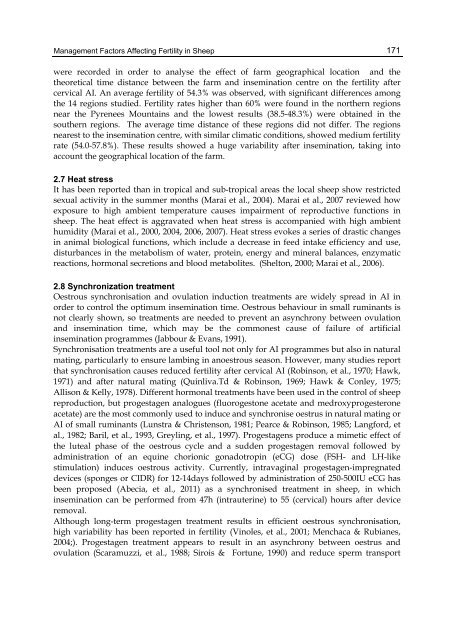ARTIFICIAL INSEMINATION IN FARM ANIMALS - Phenix-Vet
ARTIFICIAL INSEMINATION IN FARM ANIMALS - Phenix-Vet
ARTIFICIAL INSEMINATION IN FARM ANIMALS - Phenix-Vet
You also want an ePaper? Increase the reach of your titles
YUMPU automatically turns print PDFs into web optimized ePapers that Google loves.
Management Factors Affecting Fertility in Sheep 171were recorded in order to analyse the effect of farm geographical location and thetheoretical time distance between the farm and insemination centre on the fertility aftercervical AI. An average fertility of 54.3% was observed, with significant differences amongthe 14 regions studied. Fertility rates higher than 60% were found in the northern regionsnear the Pyrenees Mountains and the lowest results (38.5-48.3%) were obtained in thesouthern regions. The average time distance of these regions did not differ. The regionsnearest to the insemination centre, with similar climatic conditions, showed medium fertilityrate (54.0-57.8%). These results showed a huge variability after insemination, taking intoaccount the geographical location of the farm.2.7 Heat stressIt has been reported than in tropical and sub-tropical areas the local sheep show restrictedsexual activity in the summer months (Marai et al., 2004). Marai et al., 2007 reviewed howexposure to high ambient temperature causes impairment of reproductive functions insheep. The heat effect is aggravated when heat stress is accompanied with high ambienthumidity (Marai et al., 2000, 2004, 2006, 2007). Heat stress evokes a series of drastic changesin animal biological functions, which include a decrease in feed intake efficiency and use,disturbances in the metabolism of water, protein, energy and mineral balances, enzymaticreactions, hormonal secretions and blood metabolites. (Shelton, 2000; Marai et al., 2006).2.8 Synchronization treatmentOestrous synchronisation and ovulation induction treatments are widely spread in AI inorder to control the optimum insemination time. Oestrous behaviour in small ruminants isnot clearly shown, so treatments are needed to prevent an asynchrony between ovulationand insemination time, which may be the commonest cause of failure of artificialinsemination programmes (Jabbour & Evans, 1991).Synchronisation treatments are a useful tool not only for AI programmes but also in naturalmating, particularly to ensure lambing in anoestrous season. However, many studies reportthat synchronisation causes reduced fertility after cervical AI (Robinson, et al., 1970; Hawk,1971) and after natural mating (Quinliva.Td & Robinson, 1969; Hawk & Conley, 1975;Allison & Kelly, 1978). Different hormonal treatments have been used in the control of sheepreproduction, but progestagen analogues (fluorogestone acetate and medroxyprogesteroneacetate) are the most commonly used to induce and synchronise oestrus in natural mating orAI of small ruminants (Lunstra & Christenson, 1981; Pearce & Robinson, 1985; Langford, etal., 1982; Baril, et al., 1993, Greyling, et al., 1997). Progestagens produce a mimetic effect ofthe luteal phase of the oestrous cycle and a sudden progestagen removal followed byadministration of an equine chorionic gonadotropin (eCG) dose (FSH- and LH-likestimulation) induces oestrous activity. Currently, intravaginal progestagen-impregnateddevices (sponges or CIDR) for 12-14days followed by administration of 250-500IU eCG hasbeen proposed (Abecia, et al., 2011) as a synchronised treatment in sheep, in whichinsemination can be performed from 47h (intrauterine) to 55 (cervical) hours after deviceremoval.Although long-term progestagen treatment results in efficient oestrous synchronisation,high variability has been reported in fertility (Vinoles, et al., 2001; Menchaca & Rubianes,2004;). Progestagen treatment appears to result in an asynchrony between oestrus andovulation (Scaramuzzi, et al., 1988; Sirois & Fortune, 1990) and reduce sperm transport










